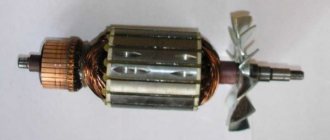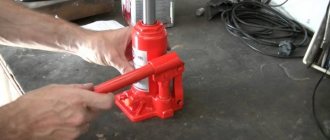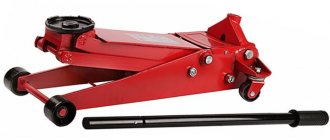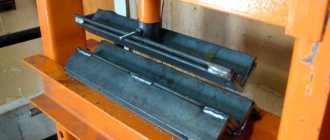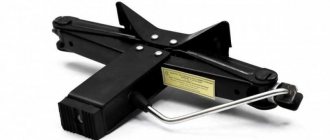A jack is a special device that is used to lift heavy loads and fix them at the desired height. The use of this mechanism is indispensable when repairing a car during the process of changing a wheel.
A hydraulic jack is considered the most convenient and effective when performing various types of work. The working force is achieved thanks to a piston, which is driven under pressure generated by hydraulic oil. However, during operation, the equipment may fail. You can assemble the device and repair a hydraulic jack yourself at home.
How does a hydraulic jack work?
A hydraulic jack is an easily transportable device that has maximum lifting capacity compared to other similar mechanisms. It is also distinguished among its peers by its durability.
Appearance
Operating principle
Externally, several details are visible:
- Cylinder - it contains a piston and two sections with working fluid.
- A pump that pumps liquid. It is connected to the cylinder by valves.
- Lever arm.
- Reference point.
The mechanism is very simple, as is the design, due to the small number of parts. It is worth considering the function of additional elements:
- The base is what the pump is mounted on. The base must have a large area to compensate for the mechanical pressure when lifting the load.
- Reserve tank - connected to the cylinder, it houses a lever system and a pump.
- The piston rises due to the flow of oil.
- Plunger - limits the height of the piston lift.
Jack parts
The jack is located below the object being lifted and does not require ropes, ropes, fasteners and other auxiliary parts. But it won’t be possible to hold an object suspended for a long time - the device serves solely for lifting.
How do the models differ?
The main distinguishing feature of jacks is their load capacity, pick-up and lifting height. With a focus on them, device models change. For example, the lifting height depends on the distance between the base and the support point. There are also some peculiarities in the lifting principle.
Another quality is wear resistance. Car enthusiasts for home use once a year and repair services need different mechanisms.
Trolley type
The entire mechanism is located on a frame, which is attached to the wheels. The compact and mobile trolley type can be used even in hard-to-reach places. The system of levers and pistons is located horizontally, making it easy to place the device under any load (for example, a car) and lift it at any angle. Additional details in the rolling model:
- 2 wheels,
- suction and discharge pump,
- lifting platform,
- frame instead of base,
- lever - you must press it to start the pump, which will transfer hydraulic oil through the valves into the cylinder.
Trolley type
Bottle type
A simple version with a vertical cylinder. A distinctive feature is its small size with a high load capacity - from 2 to 50 tons. The pick-up height in bottle jacks usually starts from 15 cm and ends at 30 cm. The height is adjusted using a screw located in the upper base of the rod. The bottle type is designed in such a way as to prevent slipping during operation. For this purpose, the supporting part is made corrugated.
Each jack comes with a handle, which makes it easier to use the mechanism. Those units that can withstand loads of 30 tons or more have an additional second handle. By doubling the length, the weight that the bottle jack can lift increases.
Bottle type
There are other types:
- Pneumatic - a cushion is installed, connected to a source of compressed air, for example, a stationary compressor. Used when the gap between the object and the surface is small. It is also possible to use it when the support is unstable - for example, in swampy areas, sand, snow. This jack can withstand loads of up to 6 tons.
- Screw - compact, standard jack for cars. Load capacity - up to 15 tons.
- Rack and pinion – has maximum lifting height. A fastening mechanism moves along the rail, which snaps into place and rises like a ladder along with the load. Can withstand 20 tons.
A jack handle is a mechanical lever that is used to pump fluid. Electric drive means that the mechanism has an automatic built-in pump. Repairing the electric version requires special equipment, while the bottle and rolling mechanical types can be repaired yourself.
Types of hydraulic jacks
There are various rolling hydraulic jacks on the market that are used for personal purposes when repairing cars whose weight category does not exceed 3 tons. However, there are also more professional models. Often such devices are equipped with pedals that allow for preliminary lifting. These types of equipment are most often used by car service centers and tire stations. This device is used to lift loads up to 4 tons, and makes it possible to complete the job faster.
There are also models of jacks that make it possible to lift loads of up to 20 tons. At the same time, they are equipped not only with a pedal that allows for preliminary lifting, but they also have a special sliding crossbeam, which is designed for servicing heavy machines and special equipment. This mechanism has a number of disadvantages, including its bulk and size, which complicates its transportation in a car. When working with such a device, you must have a flat horizontal surface, for example, asphalt or concrete.
What types of breakdowns happen and what causes them?
Hydraulic jacks are the most durable. Their malfunction may be caused by improper operation or wear of individual parts. A common problem is lifting weights that exceed the unit's capabilities. Then you can observe the following “symptoms”:
| What is observed | Where is the breakdown? | Why did it break? | What to do |
| Stop | In a cylinder | Not enough oil, filters may become clogged | Disassemble the device. Fill the oil compartments, clean the filters |
| Piston does not rise | In a cylinder | Lack of pressure due to lack of sufficient working fluid | Add liquid |
| The rise is very slow or, conversely, jerky | In a cylinder, system with working fluid | Air has entered the jack, which negatively affects the operation of the piston. | It is necessary to add liquid and remove air through the tubes |
| Low pressure | Valves | The springs have weakened |
Read also: How to determine spring stretch formula
Valves move away from the compartments
Valves are dirty
If possible - repair or cleaning
In other cases, it is necessary to disassemble the mechanism and put it back together so that the following conditions are met:
- The valves fit tightly.
- Sufficient amount of working fluid in the departments.
- There is no air in the system.
DIY repair
A hydraulic jack rarely breaks down seriously, most often the problem is contamination, valves or lack of fluid. All of these are easy to repair, as well as fixing the more rare problem of leaking.
Valve failure
Attention is paid to how the valves fit into the seats. If the contact is loose, check the springs, which may have weakened. The valves could be clogged, so you need to remove the dirt with a damp piece of cloth, then dry thoroughly. If the contamination is severe, for example due to oil, then rinse with gasoline or kerosene. Then dry with compressed air.
Jack diagram
If the valves are deformed, they must be replaced with new ones.
Liquid leak
Occurs with mechanical damage and breakage of parts. It is necessary to completely disassemble the jack, simultaneously checking metal parts, for example, the piston, for corrosion. Elements, in particular the rod, are checked for deformation. Damaged parts are replaced with new ones.
It is recommended to drain all the oil and wash the jack and parts with kerosene. Old cuffs and sealing gaskets are replaced with new ones.
How to remove air or dirt
Air accumulation is inevitable during continuous operation. In the same way, dirt gets inside the working cavity.
The air is eliminated when changing the oil. Dirt is removed with a sediment removal solution.
Disassembled jack
Oil leaks
To repair a hydraulic jack yourself, you should have a ready-made repair kit. But before you begin such work, you should familiarize yourself with the diagram of the equipment and the principle of its operation.
The most common repair that needs to be done when using this type of jack is repairing oil leaks. Why is this happening? The reason for this is usually mechanical damage to certain parts of the equipment or their wear.
Jack repair
When starting to repair a hydraulic jack with your own hands, you should prepare a container in advance where you can drain the old oil, as well as prepare a new fluid that will be poured into the device.
First of all, the pistons are removed and checked for signs of corrosion. It, like any contaminant, must be carefully removed. At the same time, the rod is also checked for deformation. If they are found, the part will need to be replaced.
Next you need to check the valve that allows oil to pass through. To do this, the device is removed, it is checked for any deformations or dirt. If the reason for oil leakage from the cylinder is valve deformation, it is simply replaced. If the reason that the valve ball does not completely melt into the seat is due to contamination, it is simply cleaned, which prevents the jack’s working fluid from leaking.
For such repairs, it is recommended to completely drain the old fluid and fill in new fluid instead. The oil is drained by bleeding the system.
After this, all parts of the device are thoroughly washed with kerosene, clearing them of old oil residues and any contaminants. In addition, it would be useful to replace the sealing gaskets and cuffs.
How to fill oil correctly
It is the lack of oil in the jack that leads to its poor performance. Fortunately, such a breakdown is easy to fix - you just need to add liquid. However, you should know what exactly to add.
High-quality fluid will ensure long-term operation of the mechanism:
- Industrial types of industrial oil. But not types I30A, I40A, I50A - they are too viscous.
- Brake fluid is excessively hygroscopic, that is, it absorbs water vapor. And water will eventually lead to corrosion and failure.
- Branded hydraulic fluids are manufactured specifically for brake and lifting systems.
- The water jack won't last long, but it will work.
After the fluid has been selected, it is necessary to carry out preparatory work to replace it.
First, the old fluid is drained. To do this, unscrew the plug and pump the device. Next, the jack is washed with cleaning fluid, which can be purchased at a hardware store. The solution is poured and drained. Before adding new oil, there should be no foreign liquid in the jack.
How to unscrew the plug
Afterwards, the jack is set to the lowest position, and the screw-cock is turned to the “Drain” position. Oil is poured. The required level is indicated by a mark on the jack.
After the first filling, the plug is closed and the jack is run 5-6 times. The plug is opened again and oil is poured in. It is necessary to repeat several times until the oil stops leaving.
After the final filling of the oil, a test distillation of the liquid is performed again to get rid of air. To do this, the jack is pumped - raised and lowered - until pressure appears. Excess air is released through special tubes; oil must be added in its place as it exits.
Recommendations for use
After finishing use, the jack must be freed from loads. The device should be stored in a warm and dry place. Due to excess moisture, the mechanism may rust, and cold will negatively affect the quality of the oil. It is recommended not to work with a jack in severe frost.
Loads on the device should not exceed those for which it is designed.
With constant use, pumping (oil change) should be carried out every 2-3 months. For rare use - once every six months.
Thus, in the event of a hydraulic jack failure, it is necessary to check 3 components:
- Quality and quantity of liquid.
- Presence of air bubbles in the system.
- Contamination, loose valve fit.
In most situations, to solve all problems with the device, it is enough to clean it and change the oil.
Good day everyone!
During the previous replacement of the pads, my favorite, dearly cherished jack broke, which had been chosen for a long time to replace the diamond in the previous car and reinforced after the gears were shifted in the upper part. The old one was also strengthened in the lower part.
It is reinforced with the same half-inch barrels, at the ends of which a centimeter groove was cut for easier installation inside the jack foot. The studs were removed and their place was taken by powerful Soviet bolts with washers and grommets (not to be confused with Chinese crap from hardware stores)). Now there is nothing to break in the jack, the metal is thick and durable, it will help you out on the road.
Since diamond jacks are still tools for emergency use only, a 3-ton rolling jack was purchased.
Read also: How to properly store a nickel-cadmium screwdriver battery
I decided to take a chance and took a rolling jack “Service Key” for restoration, catalog number 75040, load capacity 3t, lifting height 150-530mm
, although at the same time there was an opportunity to purchase a new 2-ton “Avtovirazh” AV-076002 for 1300 in Chumadan.
But 3 tons is still 3 tons! In addition, a large and massive jack is more suitable for working with Qashqai. The jack was received in a non-working condition, according to the former owner, “it doesn’t rise all the way and who the hell knows what’s wrong with it...”. So what did I do? The first thing I did was disassemble it completely and wash it.
There was no oil in the jack. Filled it up. Choked from the plunger. The rod began to twitch and... nothing. The first experience was unsuccessful.
I monitored the Internet. I read and looked at everything about jacks, rolling jacks and others))). On the drive I found information about a similar jack from SarEcks
.
I contacted him, then three more owners of 2 tons and samodelkin689
,
Godmask82
and
COSWORTH23
. Thank them very much for their response and participation. But the design of those jacks was similar, but the plunger pump was still different from mine. It was decided to buy new seals. Shopping trips for passenger cars yielded nothing. The store bought rubber rings for Belaz-Kamaz trucks with a reserve.
Balls from bearings of various diameters were found, and a BiC automatic ballpoint pen was disassembled in order to obtain a spring. Next, I will write strictly to the point, for those who are faced with repairing a jack. I've seen enough lyrics on the Internet and haven't found any specifics that apply to my jack. There are 4 balls in the jack
.
These are valves. Moreover, one of them is located in the plunger channel leading to the main (working) cylinder (check valve). IT DOESN'T COME OUT
! The second ball with a diameter of 3 (or 4) mm is located in the bypass valve. The third ball with a diameter of 6.5 mm is in the bypass valve. The fourth, with a diameter of 6 mm, is located at the base of the main cylinder, in a recess and must be pressed with a spring (like from a ballpoint pen) 8 mm long. The other end of the spring rests against a large washer, which simultaneously serves as a seal for the main (working) cylinder. Often no one knows about this necessary spring, but if it is missing, the jack may not work!
When inserting the piston, the twisted working cylinder should not leak at the point of contact with this washer. In my jack, half of the shut-off valves were missing and the plunger pump was leaking. 2 new rings were installed on the plunger: one in its regular place, the second, I moved the plastic ring into the formed groove. Those. The result was three seals for the plunger rod: the piston itself and two rings. A paronite washer is installed under the screw-in pump housing for sealing instead of the old steel one.
Now the pump does not flow. In the large piston, the O-ring is replaced with a ring of the same diameter, but thicker.
That's all the work done. The jack works great.
The car can easily be lifted half a meter on 2 wheels.
I hope this description helps someone. If you have any questions, I will be happy to answer. Peace and goodness to everyone.
When lifting heavy objects to a small height, a special technical device of a hydraulic, pneumatic or mechanical type is used. The operation will be performed by a small but strong device known as a jack. It is possible to repair a rolling hydraulic jack yourself.
Hydraulic jack repair
Hydraulic lifting devices require periodic maintenance, which is why it is necessary to add oil to the working cylinder, which leaks out through various seals and oil seals during operation. In addition to the question of how to bleed a hydraulic jack with your own hands, problems may also include jamming while lifting the car to the required height, as well as the inability to lift even a light load or the inability to release the piston after lifting.
Oil leak
To test or repair the jack yourself, you must purchase the required repair kit . Before repairs, you must first disassemble the unit. To do this, you may need an extension to the keys to get more leverage and significant force. Also, be sure to prepare containers for used oil and prepare new oil.
Then you need to remove the pistons and check them for corrosion. All corrosion and dirt must be removed. Check to see if the stem is bent. If deformation does occur, then it is unlikely that you will be able to level it again, so you can complete the repair with your own hands.
It is also worth checking the valve that transfers the oil. Why it is unscrewed and checked for dirt or deformation. If the valve is broken due to mechanical deformation, it simply needs to be replaced. In this case, it may simply become clogged, and the ball begins to sit loosely in its place. This is the reason for oil leakage.
Pour out the old fluid completely. This is a fairly simple procedure, although it will take you a lot of time while the liquid flows through the cylinders. The oil is drained by bleeding the system by moving the lever up and down. Wash all elements thoroughly to remove any remaining oil and dust. Completely replace all seals and seals .
Another reason for jack failure is dirt that gets into the working mechanism. To remove it, you need to unscrew the housing head, pour kerosene into the base and pump the jack with the locking needle unscrewed. At the end of the operation, the kerosene must be removed and new oil must be poured into the working part.
How does a hydraulic jack work?
By design, compact lifting mechanisms are divided into several types, each of which has individual characteristics. The hydraulic parameters of all elements of the model are reliable, have sufficient load capacity and durability.
When choosing a model, it is necessary to take into account the operational features of the device, permissible loads on the mechanisms, scope of application and how to properly fill the unit with oil. For example, the following types of jacks are suitable for a car repair shop:
- rolling;
- bottle;
- manual;
- electric
- hooked
- diamond
Product performance depends on product design, operating conditions, operating load, and ambient temperature. If in a rolling jack the entire load falls on the support frame, then the design of a bottle-type hydraulic jack provides for the presence of a vertical cylinder shaped like a bottle. The device has compact dimensions, reliability and high performance, and is often included in vehicle equipment.
Among all the presented models of lifting mechanisms, the bottle jack is the most popular due to the ability to apply little effort when lifting a heavy load. Restoring the device's functionality can be done at home; to repair other types of devices, the help of a professional workshop is required.
Hydraulic jack device
The main elements in the design of a hydraulic jack are:
- metal case;
- hydraulic piston;
- working fluid.
The hydraulic jack can have a regular or extended body made of hardened metal. The housing performs the following functions: it is a container for working oil and acts as a guide cylinder for the piston.
This type of unit is equipped with a hydraulic pump with air, foot or hand drive. The design of the jack contains safety valves and other devices to maintain trouble-free and long-term operation.
A retractable hydraulic cylinder and a lifting mechanism , which raises a special platform, are located in the housing openings. Lowering occurs by turning the T-shaped handle. The design has built-in wheels that provide mobility to the device. The elongated body of the shooting range is usually used to work with heavy vehicles and buses.
Principle of operation
Any hydraulic lifting mechanism works using fluid according to the principle of communicating vessels.
Before work, you need to install the unit on a hard and level surface under the car and, with the valve closed, hold the lever until the car reaches the required height. The machine is lowered by opening the valve located on the jack body. The operating hydraulic oil is pumped by the drive pump using a lever. The liquid moves into the cylinder through the valve, squeezing it out. The return of oil is prevented by two valves - suction and discharge. In order to lower the jack, you need to open the valve on the pump, in this case the liquid flows from the cylinder back into the housing.
The presence of threads on the body, protected by a special casing, threaded holes in the base and threads on the rod, guarantees unlimited operation of the jacks and the possibility of use for bending, clamping and crimping. A reliable support made of hardened metal and mounted on the rod protects the lifting mechanism from damage. The corrugated part of the base prevents the car from sliding.
Advantages and disadvantages
Hydraulic jacks are considered the most unpretentious . The main feature of hydraulics is the incompressible working fluid. The result is smooth lifting of the load, precise braking and fixation at the required height. Hydraulic jacks have excellent efficiency - up to 85% and a large load capacity - over 250 tons with little effort, thanks to the high gear ratio between the surfaces of the cylinder and the pump plunger.
But with hydraulic lifting devices, the initial lifting height is much higher, unlike mechanical devices. Another difficulty is the inability to accurately adjust the lowering height. To support the jack in the working position, you need to constantly monitor the tightness of the seals and valves, as well as monitor the oil level. These units can only be stored and transported in a vertical position, otherwise liquid may spill out of the housing.
Disadvantages of hydraulic jacks:
- They are quite slow.
- They are large in size and weight.
- High price.
- Small stroke for single plunger jacks.
Bottle (vertical) jacks
The design of a hydraulic vertical jack is the simplest.
The scope of use of these jacks is quite extensive due to the significant range of the load being lifted - from 3 to 200 tons. Bottle jacks are used in trucks. In addition to the main advantages of a hydraulic jack, bottle models have several more - a large support area, compactness and versatility of use. Vertical jacks can be double-rod or single-rod. The single-rod device is characterized by ease of use and simplicity of design, which expands the scope of its use and makes it possible to perform work of varying complexity:
- dismantling and installation in construction and mechanical engineering;
- repair of carriage and car wheels;
- use as a power unit of a pipe cutter, pipe bender, press and similar tool.
The two-rod telescopic jack has a similar design to the vertical one; the operating principle of the bottle mechanism is based on the installation of several rods. The piston is located at the base of the telescopic device. It can be used in vertical and horizontal position. It fits most cars and has small dimensions. Lifting occurs using a lifting lever, which is brought into working position by a cylinder.
Rolling jacks
This type of jack works on the same principle as the vertical one, but with the difference that the cylinder is not in a vertical position, and the piston is not directly combined with the pick-up. This device is called a rolling device because it is a cart on wheels that can be rolled along a surface. When the lever is raised and picked up, the jack moves or “rolls” under the load .
This jack is set in motion, like bottle machines, by swinging the lever, and is also lowered by unscrewing the valve screw. If it is necessary to lower the load, then you need to attach a tubular handle to the valve screw, then the partition fits into the groove of this screw. By turning the handle around the axis, the operator also rotates the screw, thus reducing the pressure in the cylinder and lowering the car to the desired height.
As a rule, a rolling jack is used at a tire station, as it is ideal for lifting one side of a car and is quite quick to install and operate. The disadvantages of this design come from the name - the rolling lifting mechanism requires a hard and flat surface, asphalt or concrete, to operate. In addition, its heavy weight and size make it difficult to transport the device in a car.
Rolling jacks are divided according to their purpose:
- For personal use of passenger cars with a carrying capacity of up to three tons.
- For tire and automotive services, with a lifting capacity of up to four tons and with the installation of pre-lift levers to quickly achieve the required pick-up height.
- For special vehicles and maintenance of heavy vehicles, with a lifting capacity of up to twenty tons and with the installation of pre-lift levers.
Scope of application
A do-it-yourself manual lift greatly simplifies repair, maintenance and tuning work related to vehicles and will help in the construction and restoration of capital structures. The presence of a compact jack eliminates the need for the car owner to visit a service center or buy a factory-made device. The lifting forces of the mechanism allow the following manipulations with the load:
- fix;
- move;
- lift up.
When planning the manufacture of a jack, it is necessary to take into account that the device cannot lift loads “from the floor”; in its design it is impossible to adjust the level of lowering; the mechanism must be transported only in a vertical position. The hydraulic system requires constant maintenance.
Read also: What is measured in microns
When working on the device, you should also take into account that the factory jack will work cyclically, and in the event of a breakdown, repair measures will require significant financial costs. A device assembled in your garage, in case of failure, can be replaced with another device of your own assembly, but its degree of reliability is reduced several times.
Principles of hydraulics
For the practical implementation of the portable lift scheme, the hydraulic jack is equipped with a system designed on the principle of communicating vessels. The operating principle of the device consists of the following operations:
- the injection pump supplies liquid from the reserve vessel to the main one;
- the working process creates pressure inside the system;
- pressure moves the piston.
Due to the fact that the design contains a small number of parts, maintenance and repair of the device does not require the use of special tools and production equipment. All elements of the device have a significant service life.
The rolling hydraulic jack contains a reserve tank with a lever system, a working piston cylinder with a plunger, and a support part to compensate for the mechanical pressure that occurs when lifting a load. The jack device ensures that the load is lifted to an allowable height equal to the distance between the base and the top of the piston.
The design of a rolling jack includes three important components, the functionality of which is determined by the force loads on the moving parts of the device. The operating principle of the components is similar to other types of compact lifting equipment, the design of which contains:
- piston;
- frame;
- liquid medium (machine oil);
- levers;
- plungers;
- valves
To pump a bottle-type jack, a mechanical force is applied to the levers, which can be increased due to the valves. The plunger transfers oil to the receiver through the movement of the piston; the return of the liquid medium and the return of the piston to its original position is carried out after opening the valve and transferring the oil to the reserve tank.
Filtered machine oil is used as a bottle-type working fluid, which allows you to work with objects weighing up to 100 kg. The main advantage of the device is the large size of the support platform . The hydraulic lifting device of the bottle model is produced in two modifications:
- single-rod units of simple design (used in the repair of cars, cars, in construction, for bending and cutting pipes);
- two-rod vertical and horizontal mechanisms.
According to the physical and mechanical characteristics, the principle of operation of devices of different models is aimed at ensuring the convenience of repairing cars, trailers, supporting structures, fencing elements and other objects that have a weight that is too heavy for a person to carry.
Operating principle of a rolling jack
Rolling jacks are a type of hydraulic tools. To manufacture the body of the device, durable metal elements are used, on which wheels are attached for transporting and moving the jack. A lifting mechanism and a hydraulic cylinder are installed in the hole on the body, thanks to which the platform rises in a horizontal position during the extension process.
The hydraulic jack is put into operation by swinging the lever, and lowering it by turning the valve screw. When the weights are lowered onto the upper part of the valve screw, the tubular handle is mounted, after which the entry of the partition into the groove is noted. Rotation of the handle around its axis allows you to directly rotate the screw itself. As a result of this, there is a release of pressure that is in the hydraulic cylinder, after which the load is lowered to the desired height. Thus, when performing simple movements, the car is raised and lowered.
When the device is broken
If the lifting mechanism breaks down, the work on repairing the technical equipment stops completely. The cause of device failure may be improper operation, foreign objects or air entering the hydraulic system. When using the lever, the piston movement may not be smooth enough and the oil pressure may decrease.
Depending on which node does not perform functions, a sequence of measures is developed to eliminate the cause. Cleaning the mechanisms from clogging, adding fluid, replacing the valve and pumping the piston system will help restore the performance characteristics of the device. Any cause of failure can be identified after removing the housing cover; if mechanical damage to parts is detected, then it is better to replace the old jack with a new one.
Unit repair
If there is an oil leak, it is recommended to find the damaged area on the housing, seal it and fill in a fresh portion of filtered oil. All measures related to restoring the operating condition of components must be carried out in accordance with the manufacturer's instructions.
If the manual mechanism refuses to lift the load, the cause may be insufficient fluid volume, excess air in the cylinder, rust particles, or rod deformation.
Bleeding the hydraulic jack after adding or replacing engine oil will help eliminate the problems; you will also need to repair the valves by replacing the gaskets.
To do this, you need to unscrew the cylinder cover screws, remove the drain valve and piston, clean the inside of the cylinder from dirt, clean the drain valve, and check the tightness of the ball to the hole under the valve. It is prohibited to use old used oil. It must be drained by bleeding the lever. The mechanisms are washed with kerosene. After this, the gaskets and cuffs are replaced, and fresh working fluid is added.
After assembling and refueling the unit, it is necessary to test the hydraulic system under load to detect leaks and the presence of an air lock in the system. Air can be released through the drain valve. The pumping procedure and maintenance of the unit are simple. The owner of the device can independently cope with the repair of the lifting device, repair the lever, and at home, pour oil into the hydraulic system.
Unlike a lift assembled at home, a factory jack has high power and efficiency of up to 80%, ease of operation, and can withstand working loads of up to 200 tons. A hydraulic device made from improvised means will cost less, but it must be done by a specialist who understands hydraulics.
Repair of valves in hydraulic jack designs
Many motorists often wonder how to repair a 2t hydraulic rolling jack.
Hydraulic jack repair at home
When inspecting the cylinder, it is advisable to ensure that there is no deformation, and if there is any deformation, the element must be repaired. If dirt is detected in the valve during operation of the lift, fluid will leak due to the fact that the ball does not fit tightly to the seat.
After the structure has been pumped and disassembled, all elements must be washed from dirt, since old working fluid may remain on them. You also need to pay attention that valve repair requires compliance with several important points, namely:
- mandatory replacement of sealing gaskets and cuffs;
- if dirt gets into the cylinder, the housing head must be unscrewed and it must be completely cleaned;
- Pour kerosene or a special flushing liquid into the tank, and then bleed the jack.



